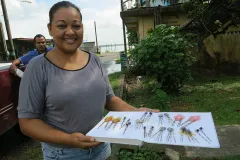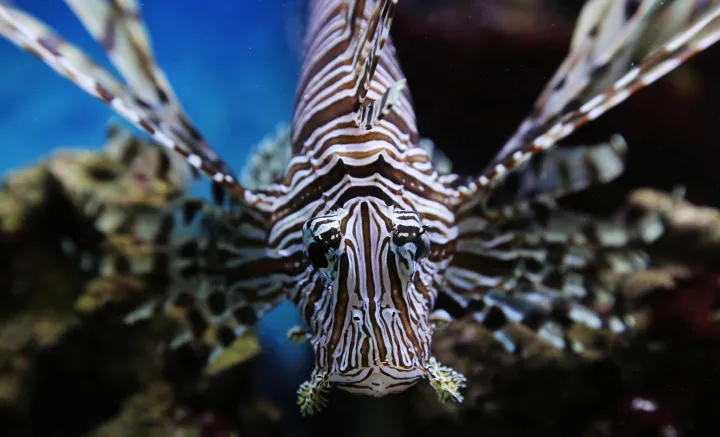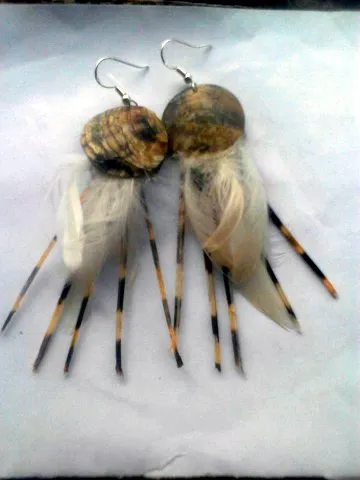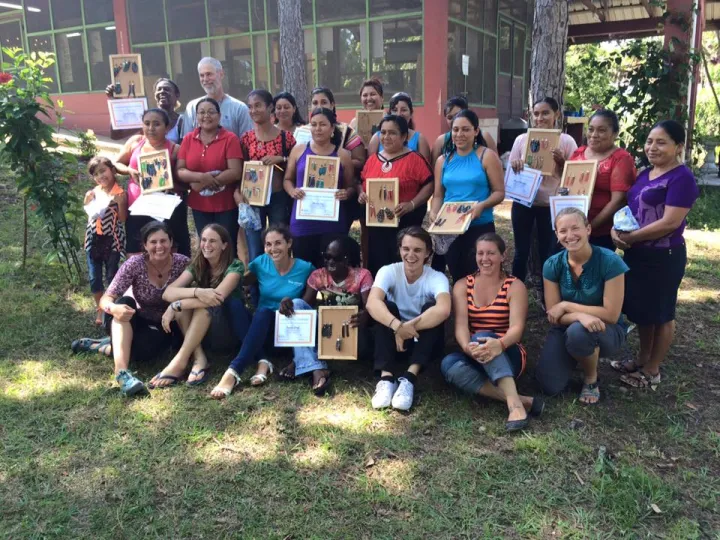When Life Gives You Lionfish…

It was the summer of 2013, and Phil Karp was staring at a dead lionfish. Earlier, he had gone diving in the waters of the Sapodilla Cayes Marine Reserve in southern Belize, armed with a spear. He and other volunteers with the organization ReefCI had attempted to hunt as many lionfish as possible.
Destructive though it may seem, killing Caribbean lionfish is actually a crucial marine conservation effort. The lionfish is a normal, benign resident in its native Indo-Pacific range—but it is an invasive, voracious and destructive predator in the Caribbean and Atlantic Ocean, where it has reduced native fish populations by 65 percent since 2004. It eats everything from parrotfish and grouper to lobster larvae and shrimp, and it has no natural predators in its new home.
Lionfish have multiplied and spread all over the Caribbean Sea, Gulf of Mexico, and the United States eastern seaboard since they were first spotted in Florida waters in the mid-1980s. Just getting the invasive population to decrease instead of increase would require removing 27 percent of all adult lionfish from the water every month, and they are almost impossible to catch except with the labor-intensive techniques of hand-netting and spearing.
But as Karp stared at the dead lionfish, he wasn’t thinking about how difficult it had been to catch. He was contemplating its spines. An adult lionfish has thirteen long, venomous spines protruding from its back, and must therefore be carefully handled even after it’s caught and killed. It occurred to Karp that the lionfish spines looked like porcupine quills, which are sometimes used in jewelry. “That was the initial ‘aha’,” he says. If people started buying previously discarded parts of the lionfish to use them in jewelry, Karp reasoned, fishers would have an additional incentive to take them out of the water.
So Karp collected and distributed spines to local artisans, including Palovi Baezar, from the town of Punta Gorda in Belize, who was one of the first in the region to make jewelry out of lionfish. She made her first pieces, several pairs of earrings, in the summer of 2013. But that was just the beginning: there were months and years of trial, error, and innovation left to go. “The first time I got to work,” recalls Baezar, “I had no idea.” At first, she used dried-out spines without treating them, and the spines were brittle and snapped easily. And it was a challenge to source the other parts of the earrings, like clasps.
But Baezar, who had been making jewelry out of sea glass and beads before she ever touched a lionfish spine, knew that this jewelry was worth the trouble. Not only could using lionfish in jewelry help incentivize the removal of this invasive species from the water, the earrings she had made were beautiful. One pair in the first batch were translucent pink diamond shapes, each dangling delicate lionfish spines from two of its corners. Another—“a favorite,” says Baezar—“had an abalone shell at the top, and feathers.”
Khadija Assales, another lionfish jewelry maker who lives in the town of Placencia in southern Belize, also remembers her first pair of lionfish earrings. She made them with the tail of a lionfish rather than its spines. “Someone gave me a tail and I was so excited to experiment with it,” she recalls. Like Baezar, she did not treat the lionfish parts the first time, beyond leaving the tail to dry in the sun. Today, in the multi-person jewelry business Assales runs, there’s an extensive treatment and preparation process for a pair of lionfish earrings. “Once we get the tail off the fish and it’s still wet,” Assales explains, “we need to dry it for at least three days in the sun.” Then, once it’s part of a piece of jewelry, “it takes another day to allow the clear coat we put on it at the very end to dry.”
Putting a coat of sealant on lionfish jewelry is now standard operating procedure with lionfish jewelers across the Caribbean—and it’s not the only innovation that has been picked up. For example, many jewelers make their lionfish jewelry entirely out of local materials, a trend for which Baezar can take partial credit. She remembers the day she came up with the idea of making a ribbon-end crimp (the metal piece that holds an earring together at the top) out of an aluminum can. “One day I ran out [of crimps],” she recounts, “and I just took a can, cut it open, and started using that.” Again, there was some trial and error. “When I folded it, [the earring] fell out,” Baezar says, “so I started gluing it.” Now, you can buy lionfish earrings with aluminum-can crimps as well as hooks made out of stainless steel fishing wire, preserved using scented nail polish remover and coated with boat varnish—all materials that a woman from a coastal fishing community can easily lay her hands on when she joins the fight against the lionfish.
But one woman can only do so much. In order for this work to put a worthwhile dent in the lionfish population and increase incentives to catch these spiny invaders, more jewelers needed to join the ranks. The next step was workshops—opportunities for those who already knew how to make lionfish jewelry to pass that knowledge on to those who didn’t. Baezar has taught at several workshops set up by Karp and the NGO Blue Ventures.
In fact, Baezar started training others to make lionfish jewelry almost as soon as she began making it herself. She has kept it up, in part simply for the joy of passing on her knowledge and expertise to excited students. “They can’t wait to be making jewelry,” Baezar says of workshop attendees. Nowadays, participants not only learn the ins and outs of making lionfish jewelry, they receive a crash course in accounting and other business skills—and they talk about the tremendous threat to reef ecosystems posed by the lionfish invasion. By the end of one workshop in 2015, the participants had decided collectively and on their own to become a cooperative of Belizean women lionfish jewelers who would collaborate, communicate and support each others’ work.
The cooperative is still going strong today. “So far there are 19 of us ladies,” says Baezar. “We don’t have a problem with guys joining, but it’s mostly for the women in the fishing coastal communities.” She explains that the lives of many of the members were transformed when they learned to make lionfish jewelry. “Some of the women were unemployed,” she says, “and they were only depending on the money that was brought in by their husbands, who were fishermen.” Now these women use lionfish—perhaps even caught by their husbands—to make money for themselves. Among the members is a single mother who not only makes and sells her own lionfish jewelry but has started an experiential tour business in which guests go on a fishing excursion with her father and brother, and then return for her to cook them a lionfish lunch. In recognition of the key parts of its identity—all women, from Belize, who help fight the lionfish invasion—the organization was named BELIONESS.
“My dream would be to have a series of cooperatives in the Caribbean like BELIONESS,” Karp confides. “[They] could then collectively create a Caribbean lionfish jewelry brand.” And if there were a brand with a great story behind it, plus sufficient amounts of jewelry to sell, Karp explains, the jewelry might be able to get into department stores, or boutiques or aquarium gift shops. Then the sales of lionfish jewelry, and the incentives to remove lionfish from the water, would really take off.
Right now, is lionfish jewelry ending the lionfish invasion? Not on its own. “I don’t know how much we’re helping with the population of lionfish,” Assales says when asked, chuckling a little. “But we also have a very big impact in spreading awareness.” Selling her lionfish jewelry involves telling people why she makes it. “A majority of the people who come into the shop did not previously know about lionfish,” she says, “and then we teach them.” Baezar does the same in her workshops. “I try to do it as I go along,” she says. “I always tell the story behind lionfish jewelry.”
It’s a story of women who are empowering themselves while stewarding their local ecosystem. What’s the moral? As with lemons to lemonade, when life gives you lionfish, make jewelry out of them.
This story was made possible by a grant from the Smithsonian Women's Committee. http://swc.si.edu/about-grants




